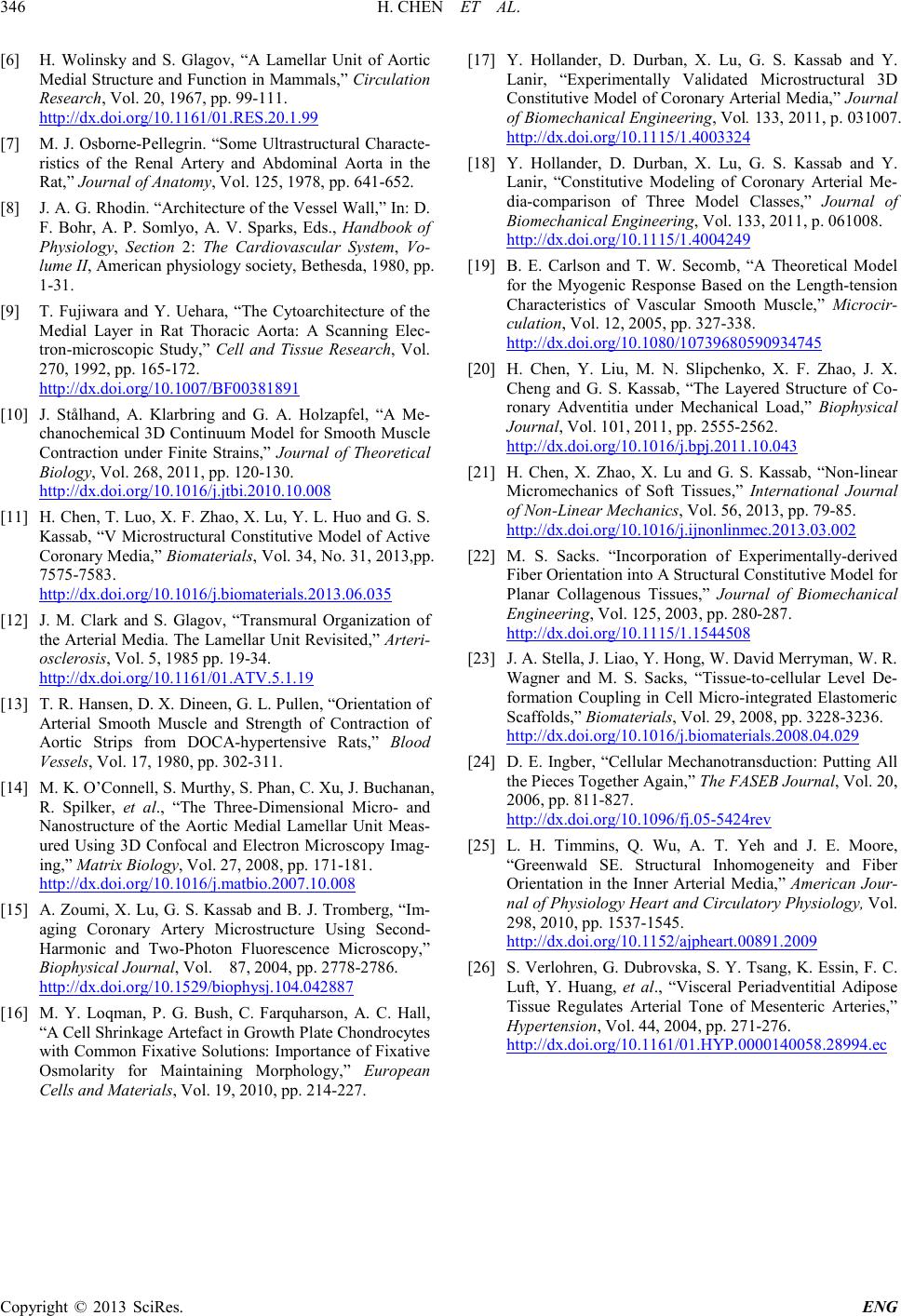
H. CHEN ET AL.
Copyright © 2013 SciRes. ENG
[6] H. Wolinsky and S. Glagov, “A Lamellar Unit of Aortic
Medial Structure and Function in Mammals,” Circulation
Research, Vol . 20, 1967, pp. 99-111.
http://dx.doi.org/10.1161/01.RES.20.1.99
[7] M. J. Osborne-Pellegrin. “Some Ult rastructural Characte-
ristics of the Renal Artery and Abdominal Aorta in the
Rat,” Journal of Anatomy, Vol. 125, 1978 , p p. 64 1-652.
[8] J. A. G. Rho d in. “Arch itect ur e of t he V ess el Wall,” In: D.
F. Bohr, A. P. Somlyo, A. V. Sparks, Eds., Handbook of
Physiology, Section 2: The Cardiovascular System, Vo-
lume II, American physiology society, Bethesda, 1980, pp.
1-31.
[9] T. Fujiwara and Y. Uehara, “The Cytoarchitecture of the
Medial Layer in Rat Thoracic Aorta: A Scanning Elec-
tron-microscopic Study,” Cell and Tissue Research, Vol.
270, 1992, pp. 165-172.
http://dx.doi.org/10.1007/BF00381891
[10] J. Stålhand, A. Klarbring and G. A. Holzapfel, “A Me-
chanochemical 3D Continuum Model for Smooth Muscle
Contraction under Finite Strains,” Journal of Theoretical
Biology, Vol. 268, 2011, p p. 120-130.
http://dx.doi.org/10.1016/j.jtbi.2010.10.008
[11] H. Chen, T. Luo, X. F. Zhao, X. Lu, Y. L. Huo and G. S.
Kassab, “V Microstructural Constitutive Model of Active
Coro nary Media, ” Biomaterials, Vol. 34, No. 31, 2013,pp.
7575-7583.
http://dx.doi.org/10.1016/j.biomaterials.2013.06.035
[12] J. M. Clark and S. Glagov, “Transmural Organization of
the Arterial Media. The Lamellar Unit Revisi ted,” Arteri-
osclerosis, Vol. 5, 19 85 pp. 19-34.
http://dx.doi.org/10.1161/01.ATV.5.1.19
[13] T. R. Hansen, D. X. Dineen, G. L. Pullen, “Ori entati on of
Arterial Smooth Muscle and Strength of Contraction of
Aortic Strips from DOCA-hypertensive Rats,” Blood
Vessels, Vol. 1 7, 1980, pp. 30 2-311.
[14] M. K. O’Connell, S. Murthy, S. Phan, C. Xu, J. Buchanan,
R. Spilker, et al., “The Three-Dimensional Micro- and
Nanostructure of the Aortic Medial Lamellar Unit Meas-
ured Using 3D Confocal and Electron Microscopy I mag-
ing,” Matrix Biology, Vol. 27, 2008, pp. 171-181.
http://dx.doi.org/10.1016/j.matbio.2007.10.008
[15] A. Zoumi, X. Lu, G. S. Kassab and B. J. Tromberg, “I m-
aging Coronary Artery Microstructure Using Second-
Harmonic and Two-Photon Fluorescence Microscopy,”
Biophysical Journal, Vol. 87, 2004, pp. 2778-2786.
http://dx.doi.org/10.1529/biophysj.104.042887
[16] M. Y. Loqman, P. G. Bush, C. Farquharson, A. C. Hall,
“A Cell Shrinkage Artefact in Growth Plate Chondrocytes
with Common Fixative Solutions: Importance of Fixative
Osmolarity for Maintaining Morphology,” European
Cells and Materials, Vol. 1 9, 20 10, pp. 214-227.
[17] Y. Hollander, D. Durban, X. Lu, G. S. Kassab and Y.
Lanir, “Experimentally Validated Microstructural 3D
Constitutive Model of Coronary Arterial Media,” Journal
of Biomechanical Engineering, Vol. 133, 20 11, p. 031007.
http://dx.doi.org/10.1115/1.4003324
[18] Y. Hollander, D. Durban, X. Lu, G. S. Kassab and Y.
Lanir, “Constitutive Modeling of Coronary Arterial Me-
dia-comparison of Three Model Classes,” Journal of
Biomechanical Engineering, Vol. 133, 2011, p. 061008.
http://dx.doi.org/10.1115/1.4004249
[19] B. E. Carlson and T. W. Secomb, “A Theoretical Model
for the Myogenic Response Based on the Length-tension
Characteristics of Vascular Smooth Muscle,” Microcir-
culation, Vol. 12, 20 05, pp. 327-338.
http://dx.doi.org/10.1080/10739680590934745
[20] H. Chen, Y. Liu, M. N. Slipchenko, X. F. Zhao, J. X.
Cheng and G. S. Kassab, “The Layered Structure of Co-
ronary Adventitia under Mechanical Load,” Biophysical
Journal, Vol. 101, 2011, pp. 25 55 -2562.
http://dx.doi.org/10.1016/j.bpj.2011.10.043
[21] H. Chen, X. Zhao, X. Lu and G. S. Kassab, “Non-linear
Micromechanics of Soft Tissues,” International Journal
of N on-Linear Mechanics, Vol. 56, 2013, pp. 79-85.
http://dx.doi.org/10.1016/j.ijnonlinmec.2013.03.002
[22] M. S. Sacks. “Incorporation of Experimentally-derived
Fiber Orientation into A Structural Constitutive Model for
Planar Collagenous Tissues,” Journal of Biomechanical
Engineering, Vol . 125, 2003, pp. 280-287.
http://dx.doi.org/10.1115/1.1544508
[23] J. A. Stella, J. Liao, Y. Hong, W. David Merryman, W. R.
Wagner and M. S. Sacks, “Tissue-to-cellular Level De-
formation Coupling in Cell Micro-integrated Elastomeric
Scaffolds,” Biomaterials, Vol. 29, 2008, pp. 3228-3236.
http://dx.doi.org/10.1016/j.biomaterials.2008.04.029
[24] D. E. Ingber, “Cellular Mechanotransduction: Putting All
the Pieces Together A gai n,” The FASEB Journal, Vol. 20,
2006, pp . 811-827.
http://dx.doi.org/10.1096/fj.05-5424rev
[25] L. H. Timmins, Q. Wu, A. T. Yeh and J. E. Moore,
“Greenwald SE. Structural Inhomogeneity and Fiber
Orientation in the Inner Arterial Media,” American Jour-
nal of Physiology Heart and Circulatory Physiology, Vol.
29 8, 2010, pp. 1537-1545.
http://dx.doi.org/10.1152/ajpheart.00891.2009
[26] S. Verlohren, G. Dubrovska, S. Y. Tsang, K. Essin, F. C.
Luft, Y. Huang, et al., “Visceral Periadventitial Adipose
Tissue Regulates Arterial Tone of Mesenteric Arteries,”
Hypertension, Vol. 44, 200 4, pp . 271-276.
http://dx.doi.org/10.1161/01.HYP.0000140058.28994.ec